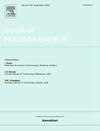Experimental study of critical heat flux for upflowed water in narrow rectangular channels with different dimensions
IF 2.3
3区 工程技术
Q1 NUCLEAR SCIENCE & TECHNOLOGY
引用次数: 0
Abstract
Flow boiling is an efficient heat transfer method; however, critical heat flux (CHF) leads to a sharp deterioration in thermal performance. As a key phenomenon in reactor systems, CHF has garnered significant research attention. To investigate the effects of geometric and thermodynamic parameters on CHF in rectangular narrow channels, an extensive experimental study was conducted across a broad parameter range, including pressures of 0.1–5.5 MPa, mass fluxes of 200–2000 kg/m2s, and inlet subcooling levels of 10–150 K. The experimental data were analyzed to elucidate the CHF triggering mechanism and the influence of various parameters. The results demonstrate that pressure, mass flux, inlet subcooling, channel length, and gap size significantly affect CHF. The Look-Up-Table method for CHF prediction was evaluated and found unsuitable for narrow rectangular channels. Comparisons with existing correlations revealed deviations in calculated results, likely due to the limited parameter ranges covered in prior studies. Based on the dimensionless correlation of heat flux and mass flux, a new CHF model was developed, incorporating channel dimension effects. The proposed correlation accurately captures the parametric trends and shows excellent agreement with the experimental data.
不同尺寸矩形窄通道上升水临界热流密度的实验研究
流动沸腾是一种高效的换热方法;然而,临界热流密度(CHF)导致热性能急剧恶化。作为反应器系统中的一种关键现象,CHF已经引起了人们的广泛关注。为了研究几何和热力学参数对矩形窄通道CHF的影响,在较宽的参数范围内进行了广泛的实验研究,包括压力为0.1-5.5 MPa,质量通量为200-2000 kg/m2s,入口过冷水平为10-150 K。对实验数据进行了分析,阐明了CHF的触发机理和各参数的影响。结果表明,压力、质量通量、进口过冷度、通道长度和间隙大小对CHF有显著影响。对查找表法进行了评价,发现它不适用于窄矩形通道。与现有相关性的比较揭示了计算结果的偏差,可能是由于先前研究中覆盖的参数范围有限。基于热流通量和质量通量的无量纲相关性,建立了考虑通道量纲效应的CHF模型。所提出的相关性准确地捕捉了参数趋势,并与实验数据表现出良好的一致性。
本文章由计算机程序翻译,如有差异,请以英文原文为准。
求助全文
约1分钟内获得全文
求助全文
来源期刊

Annals of Nuclear Energy
工程技术-核科学技术
CiteScore
4.30
自引率
21.10%
发文量
632
审稿时长
7.3 months
期刊介绍:
Annals of Nuclear Energy provides an international medium for the communication of original research, ideas and developments in all areas of the field of nuclear energy science and technology. Its scope embraces nuclear fuel reserves, fuel cycles and cost, materials, processing, system and component technology (fission only), design and optimization, direct conversion of nuclear energy sources, environmental control, reactor physics, heat transfer and fluid dynamics, structural analysis, fuel management, future developments, nuclear fuel and safety, nuclear aerosol, neutron physics, computer technology (both software and hardware), risk assessment, radioactive waste disposal and reactor thermal hydraulics. Papers submitted to Annals need to demonstrate a clear link to nuclear power generation/nuclear engineering. Papers which deal with pure nuclear physics, pure health physics, imaging, or attenuation and shielding properties of concretes and various geological materials are not within the scope of the journal. Also, papers that deal with policy or economics are not within the scope of the journal.
 求助内容:
求助内容: 应助结果提醒方式:
应助结果提醒方式:


